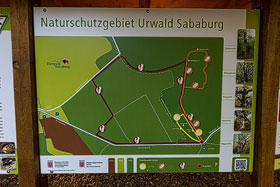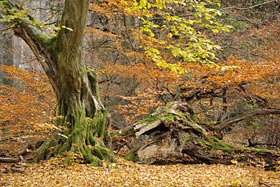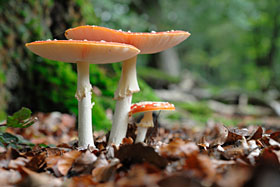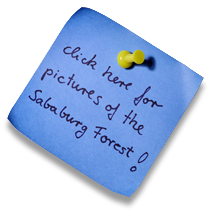- Location and arrival
- The jungle
- Photography in the forest
- The challenge
- More details
- The seasons
- The equipment
- Conclusion
- Download maps Sababurg Forest
The Sababurg Forest is located in Hesse and is situated approximately 25 km north of the city of Kassel.

For better orientation, I have attached an overview map on the left (click on the map for more details). Coming
from the west, take the K55 county road from the A44 motorway (exit 65) towards Hofgeismar and reach the Sababurg Forest through the small
village of Beberbeck. When driving to the forest, follow the signage for the "Sababurg Wildlife Park" as the wildlife park is only about
1.8 km east of the K55 county road. If arriving via the A7, follow the B80 federal road to Veckerhagen and then continue on the K55 county
road towards Sababurg from the "Kasseler Straße".
The 92-hectare "Sababurg Forest" is located in the middle of the large Reinhardswald and is the oldest nature reserve in Hesse. You can obtain
a more detailed map at the end of this report in the "Download" section.
(back to the top)
Although I focus on the photographic opportunities when describing my travel destinations, I would like to share a few things about the forest's
origin. The term "jungle" is somewhat misleading as it is actually an old "Hutewald." A Hutewald is a forest that was used for livestock farming in
previous centuries. Grazing led to open forests with little undergrowth, allowing the few trees in the forest to grow freely. Livestock farming was
discontinued about 100 years ago, and to prevent the forest from becoming a pure beech forest through normal forest development, the oaks are
occasionally cleared. Otherwise, the forest is left to its own devices, and fallen trees are left to natural decay.
(back to the top)

The Sababurg Forest offers various circular hiking trails of different lengths. Those who choose circular hiking trail 1
(see map on the right) can complete it in half an hour. Of course, this does not apply to nature photographers who may need several hours for the same
distance ;-). The forest is characterized by ancient oaks (up to 800 years old) and massive beech trees. Additionally, in some places, you come across
the up to 2-meter-high eagle fern, which winds enchantingly around the thick trunks.
(back to the top)

When walking through the forest, one doesn't have to search long for subjects as a variety of photographic highlights are offered along
the circular trail. Nevertheless, photographing in the forest is always a very special challenge. Why is that? In no other topic in nature photography, it is more
important to infer from the spatial impressions one has on site of the scene to the later effect of a much smaller representation, namely the photo, which is also
two-dimensional. Another challenge is the high contrasts between bright and dark parts of the image encountered in the forest. Especially when sunlight penetrates
the forest, it is impossible for digital camera sensors to capture the entire contrast range without losing detail in the shadows or highlights. Therefore, my
recommendation on a sunny day is to use only the very early hours of the day, or the time 1-2 hours before sunset.
(back to the top)

One should not lose sight of the details amidst the towering trees. Forest scenes often appear chaotic as there is simply too much to take in on a
single image. It often makes sense to focus on a particular aspect of a tree, such as its roots or interesting bark texture. Of course, there are also countless macro
photography opportunities to be found. For example, in the Sababurg Forest, several hundred species of beetles have been identified that benefit from decaying wood.
(back to the top)

The beauty of forest photography is that interesting subjects can be found in every season. The forest takes on a completely different character in
winter compared to the warmer months. Autumn has its own unique charm and if one is lucky enough to be there at the right time, they can experience a hint of the Indian
summer. One should not be too impressed by the weather. Although nature photographers often hope for sunny conditions, as mentioned earlier, there are difficulties with
the sun in the forest. Therefore, even "bad" weather can be usable in the forest. After a brief rain shower, for example, the colors of the moss are particularly beautiful,
or one can be inspired by a little ground fog.
(back to the top)
The most important piece of equipment is the tripod. Light in the forest is scarce, and when stopping down the aperture, shutter speeds of less than 1/30s are often necessary.
A wide-angle lens should not be missing, nor should a medium telephoto lens. In this case, I prefer a 70-200mm telephoto zoom (full-frame equivalent). Furthermore, a macro lens
should complete the kit. For ground-level work, I always carry a small beanbag and a plastic sheet to keep the dirt off my pants.
(back to the top)
I can really recommend the Sababurg Forest to anyone who enjoys nature photography in the forest. Although the forest is a popular destination for many visitors, the crowds are
still manageable. However, this may also be because I usually photograph there at times when others don't think to walk around.
If you want to visit the Sababurg wildlife park in addition to the Sababurg Forest, simply drive along the county road 2 km to the east. Unfortunately, I cannot personally comment
on the Sababurg wildlife park as I do not photograph animals in enclosures and have not visited it. Adjacent to the wildlife park is the Sababurg castle, which dates back to 1334
and is open to visitors.
(back to the top)
Here you can download maps for the Sababurg Forest. To view and print them, you will need Acrobat Reader. I hope the maps will help you find your way to the jungle and prevent
you from getting lost while you're there ;-)
 map Sababurg Forest
map Sababurg Forest
written: January 2010, (author: Olaf Juergens)
updated: November 2016
 print version
print version








